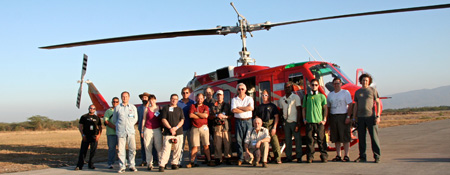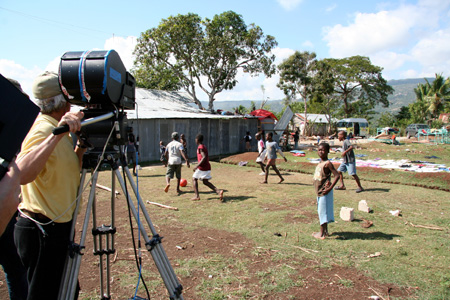The Making of Rescue

The latest production from Stephen Low is Rescue. Filmed for presentation in IMAX® 3D and 2D, Rescue documents the work of the Canadian Navy and its international counterparts (U.S. Navy, Air Force and Air National Guard and NGOs) engaged in the vital work of responding to major disasters and emergencies around the globe. Rescue was filmed in the North Atlantic, Halifax, Montreal, California, Nevada and on location in Haiti in the aftermath of the 2010 Haiti earthquake.
Rescue follows the stories of four main characters: Canadian Navy Commander Peter Crain of HMCS Athabaskan; USAF Captain Lauren Ross, pilot of a C-17 military transport airplane, U.S. Army Major Matthew Jonkey, pilot of a CH-47 helicopter and; Steven Heicklen volunteer Emergency Manager, as they respond to Haiti’s massive 2010 earthquake.
For Rescue, the production team arrived on site February 2nd, 2010, two weeks after the initial quake in Haiti. The situation on the ground was still in flux — and dangerous.
In comparison to conventional crews, filming in a situation such as the aftermath of the Haiti earthquake, where you’d have maybe a 2 or 3 person team, for IMAX® 3D, a crew of nine people was necessary. The camera itself requires more personnel, for rigging and so on. There was also some lighting gear, though minimal considering the situation — and all this equipment had to be mobile. When shooting stereo film, many elements are doubled: two film magazines have to be loaded instead of one and you’re carrying twice as much film at any given moment.
To form a plan of action before departure, the production screened information from a wide range of sources — such as the World Food Program, the U.N., various NGOs and online sources — and they pre-established contacts with the Canadian Navy and the U.S. Air Force. But the information was inevitably incomplete — the actual situation on the ground in Haiti was simply too chaotic.
The production team didn’t want to go into the heart of the disaster, where they might contribute to the confusion — and possibly get stuck. So a decision had to be made where to go in Haiti and how to get there. It was decided against going by boat. Instead, the team went via the Dominican Republic. With the assistance of a production company on the ground in Barahona, Dominican Republic the team was able to organize the logistics of accommodation, vehicles and also how to get into Haiti from Barahona.
But where to go in Haiti? Luckily, months before, the IMAX® team had begun filming Rescue aboard the Canadian naval ships HMCS Athabaskan and Halifax. They’d already filmed training activities during an Atlantic naval crossing, and by remarkable chance, the same ships were being sent to Jacmel in Haiti. So it was decided that Jacmel would be the crew’s prime destination. From there, they’d have to improvise.
Arriving in Haiti, a country with virtually no surviving infrastructure, was like arriving in a war zone. With a lot of military personnel and equipment from around the world present as part of the rescue effort — and crumbled buildings everywhere which looked like they’d been bombed out — it really contributed to the war torn feeling.

The production team did not want to impose itself on Haiti with the region already stretched for resources. It was decided the team would stay in the Dominican Republic, and everyone flew in and out each day by helicopter, meeting up at a pre-arranged location in Haiti with a flat-bed truck, hired from a local trucking company (which was completely out of work due to the quake). This flat-bed served as the production’s mobile base camp during the time in Haiti. A guide was also hired who spoke Creole.
The guide took them around, and they followed director Stephen Low’s “nose”; his instincts for where they’d find the right moments to film. Stephen wasn’t looking for anything bloody or shocking. He wanted to show the scope of the disaster and how NGOs and militaries from around the world were helping.
Going into places where there is a lot of misery, where kids pull at your shirt and say I’m hungry, you have to keep your armor up, so as not to just stop and break down; each day the team brought along a cooler with food, biscuits, granola bars, etc, but they felt they simply couldn’t eat in front of their drivers and other Haitians, so they gave all the food away, except for keeping some water. It felt wrong to be “stuffing your face” when you saw what was going on. Crew members came back deeply disturbed and upset. They came back with a lot of troubling memories.
The film crew flew from Barahona into a little airport near Jacmel, meeting up with the Haitian drivers and guide on a daily basis. It was a little crumbled up airport. On the first day of filming, the crew linked up with DART (the Canadian Disaster Assistance Response Team). From there, the production went with whatever was presented or seemed interesting, for example going to an orphanage being rebuilt by the Canadian Navy. Daily improvisation was essential.
Communications were spotty in Haiti, and the team was often in the dark during the day. They remained in contact through the main base in the Dominican Republic where they returned each night, checking in with the production company in Montreal. For example, they’d receive a message in the Dominican Republic forwarded from Ottawa, sent from the Athabaskan, saying the navy was ready to greet the film crew and show them around Leogane. A lot of this was done by text messaging; for some reason, Blackberry texting worked while cell phones did not. Even the military said that texting was their main way of communicating! Suffice it to say communications were a bit complicated. It was the same with the contacts with the U.S. military and Air Force. The K2 co-producers (American based) would get word from the 82nd airborne regiment from L.A., which would be transmitted to the Dominican Republic and then the film crew would arrange to fly in by helicopter to meet with the 82nd.
Just getting a helicopter was a task in itself. First of all, the spacecam mount doesn’t fit on just any helicopter. And a lot of helicopters in the immediate area around Haiti were being used for rescue operations. The production eventually found a suitable helicopter in Puerto Rico, so they had to fly the spacecam from L.A. to Puerto Rico, and then the helicopter had to make short refuelling hops to reach Haiti. They shot for four days with the helicopter mounted spacecam, with the director on board. Meanwhile, the rest of the film crew in Barahona prepared for shooting on the ground in Jacmel. The spacecam footage gave the team a sense of what was happening and what route to take for further filming.
For getting authorization to fly in Haitian airspace, the U.S. military base unit SOUTHCOM had to be contacted. SOUTHCOM was in charge by request of the Haitian government. Their reply to the production team was: come on in — just wing it! It was a free for all. You had to be careful with radar, watching for wandering aircraft. You had to observe by eye. Mid-air collisions were a real concern … and the helicopter had to fly frequently into Port-au-Prince for refuelling.
It was on one of these refuelling trips that the film crew met Stephen Heicklen, a volunteer emergency manager with a number of disasters under his belt. Through force of personality, Heicklen hitched a series of rides on the production’s helicopter to Port-au-Prince. He “hijacked” the documentary crew, which was fortunate; they later filmed him organizing a medical evacuation, and Heicklen became one of the principal characters in the film — an example of a documentary film being a true work in progress. At the same time, the production was not satisfied documenting the disaster from the sidelines, but contributed to the relief effort by donating the use of their helicopter to airlift victims of the earthquake.
